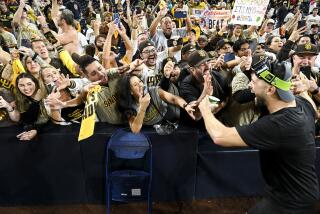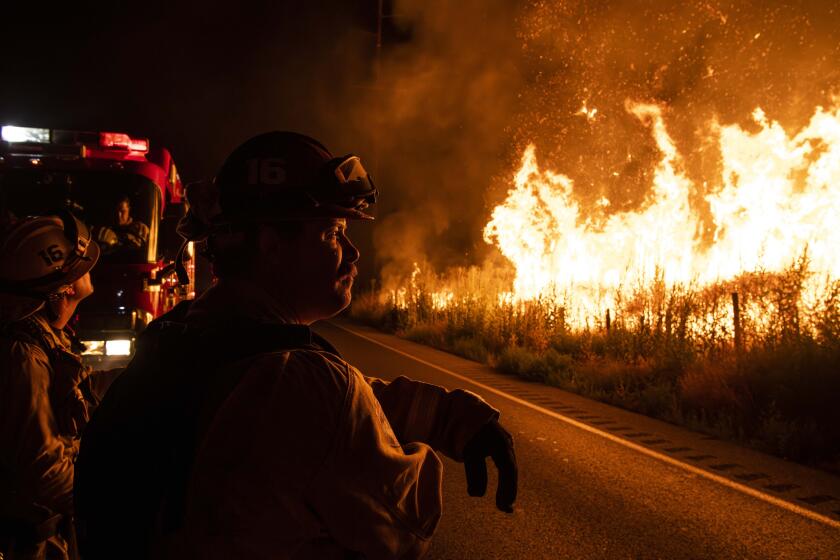$141 Million for San Diego but It May Not Be Enough for Some : ‘Secret’ City Squirming in Super Bowl Hype
- Share via
SAN DIEGO — It begins today, that curious cavalcade of hype, corporate extravagance, news media overkill, technological wizardry, Chamber of Commerce chest-thumping, consumption, celebration and athletic deification called the Super Bowl.
It is at once intrinsically trivial--a sporting contest of running and throwing and tackling--and loaded with cultural meaning, a game that brings the nation to a halt and a fortune to a city.
Here in San Diego, which is host to the game for the first time, it’s being seen as all that and potentially much more, a national coming-out party for this burgeoning city.
Today begins the one-week countdown to the game next Sunday, in which the Washington Redskins and the Denver Broncos will meet for the championship of professional football.
“There’s no question about the prestige it brings the city,” said Mayor Maureen O’Connor. “It also gives us an opportunity to show off San Diego.”
Economic Benefit
A study commissioned by the San Diego Super Bowl Task Force, the group responsible for preparing the city for this week, estimates that San Diego’s direct economic benefit as host of the game could reach as high as $141 million, but the city hopes for more--that the hoopla of the event will serve as one big commercial.
As with most commercials, the message is sublime.
“If there is an underlying objective of the task force,” its Chairman Robert Payne said, “it’s to promote San Diego as a destination resort.”
There are those, however, who believe that the Super Bowl might be the worst thing to have happened to San Diego. For them, the Super Bowl can’t make the sunshine any sunnier, won’t bring the beach any closer or make the air any fresher.
“San Diego is terrific because it’s somewhat of a secret. It’s Los Angeles without the lesser qualities of L.A . . . the smog, the traffic,” said David Halberstam, the New York City-based author of several books, including some dealing with sports, who has visited the city frequently.
“It’s a wildly livable city. You don’t want to expose it to 1,000 reporters,” he said. “With luck, the game will be played, and it will last about three hours, and everyone will go home, and the Chamber of Commerce will claim it’s a huge success, and you won’t have another one for 10 years.”
And for some, 10 years might be too soon.
While residents seem resigned to some inconvenience, there are those who believe that they are being taken advantage of. They don’t buy the explanations that the inconveniences are outweighed by the benefits.
Most prominent among these residents are people living near the airport, where the late-night curfew on takeoffs was lifted last week so that the squadron of up to 300 private jets expected for the game can leave the night after the game.
“I don’t blame the Super Bowl. What I’m angry about is the planning was so terribly mishandled,” said Nancy Palmtag, a Point Loma resident who lives under the flight path and spokeswoman of the Airport Noise Coalition.
“Where was the planning to get 80,000 people in and out of the city? The fact is, they blew it, and that should be a source of embarrassment to this city. They shoved it down our throats,” she said.
Compact Confines
Unlike last year’s event, much of it swallowed by the megalopolis of Los Angeles, the Super Bowl is expected to dominate the more compact confines of central San Diego.
A city of striking physical beauty, with rolling hills, miles of beaches, dramatic views of the bay and a benign climate, San Diego passed the 1 million population mark last year. It is growing at such a rate and stretching the city’s ability to provide services to its new residents, that the question of growth and its implications dominates political debate at City Hall.
In 1986, the last year for which figures are available, 20,000 new people moved into San Diego. The county that year grew by 75,000 residents, and the trend shows no signs of weakening. The city is the state’s second largest.
San Diego is a young big city and often recoils at any slight made to its image. The city slogan is “America’s Finest City,” and two weeks ago, civic leaders immediately criticized as inappropriate 100 placards placed on city buses by three local artists that were a commentary on the city’s tourism industry. The placards, consisting of three photographs depicting the shadowy existence of illegal aliens in the city’s hotel and restaurant work force, were titled “America’s Finest Tourist Plantation.”
Daily Column
The city’s metamorphosis, apparent in its changing downtown skyline and aggressive can-do business attitude, has left some natives and old-timers questioning where the city’s soul lies. Neil Morgan, editor of the Tribune, the city’s afternoon newspaper, for 42 years has chronicled life here in a daily column. Last November, he wrote about San Diego after visiting Sydney, Australia:
“San Diego’s harbor is no less beautiful than Sydney’s. But it’s not as accessible or as inviting. Sure, there are handsome parks and walkways, part of the largess of a rich Port District. But they are not yet linked with a place of pride, a natural gathering site, a wellspring of civic identity. . . . We are still searching, in San Diego, for ourselves.”
While some boosters have suggested that the Super Bowl will begin a new era of civic achievement in San Diego, others say it is unlikely to make that much difference.
Bruce Ogilvie, a sports psychologist who has worked for 35 sports teams, including the U.S. Olympic volleyball team, specializes in the research of high-level performance and performers. A resident of San Jose, he said this about the Super Bowl:
“All you have is a bunch of good-time Charlies putting on a spectacle, and that’s OK, because we need spectacles. But like every Fourth of July, you wave your sparklers, booze it up and party for a day. I’m not knocking it, but it makes no profound statement about your city or mankind.”
Stands to Gain
One hundred and forty-one million dollars. That’s how much Super Bowl Task Force officials say San Diego stands to gain from the Super Bowl, money spent on a plethora of activities, on taxis, meals, rental cars, a good time.
“The games have become anticlimactic . . . a three-hour pause in the activities,” said Leon Parma, a task force member and owner of one of San Diego’s largest liquor distributorships, Coast Distributing. Of the 21 Super Bowls played, Parma has attended 18.
As much as the direct dollars and cents impact of the event, people like Parma are counting on using the Super Bowl as an opportunity to tout the city to thousands of business leaders expected in town. Their logic is that duly impressed visiting executives will think of San Diego at expansion time.
“The business sector will see San Diego. . . . There will be more of them than have ever been put together by all the economic development efforts we’ve ever done, combined,” Parma said. “At last year’s Super Bowl, Lee Iacocca sat behind me. . . . It’s an extraordinary opportunity.”
With equal verve, city officials hope that the Super Bowl will help buttress San Diego’s tourism industry. Last year, about 32 million tourists visited the city, and the tourism accounted for $2.5 billion to the economy, making it San Diego’s third-largest industry.
“The business that will benefit the most (from the Super Bowl) is tourism,” said Dal Watkins, president of the San Diego Convention & Visitors Bureau. “We’re still not known internationally. We want to showcase San Diego.”
Impossible to Gauge
Despite all the civic enthusiasm, though, it’s nearly impossible to gauge the impact of a single large event like the Super Bowl on long-term tourism and population growth. That was the conclusion of a study called “Causes of Growth” done by the San Diego Assn. of Governments, the area’s agency for regional government. Between 1980-86, the county grew by 344,000 people, according to the study, but only about 13% of that growth, or 46,000 people, was related to the effect of tourism or boosterism.
“What effect does the Super Bowl have versus a four-page color spread in Fortune (magazine)?” said Linda Martin, co-chairman of San Diegans for Limited Growth, the group sponsoring a restrictive anti-growth initiative.
While Martin would like to see more studies done on what events like the Super Bowl and the upcoming America’s Cup regatta do to influence growth, she is not about to become the “grinch who stole the Super Bowl.”
“There probably is a downside to the Super Bowl,” she said. “But it’s also a great deal of fun.”
More to Read
Sign up for Essential California
The most important California stories and recommendations in your inbox every morning.
You may occasionally receive promotional content from the Los Angeles Times.










